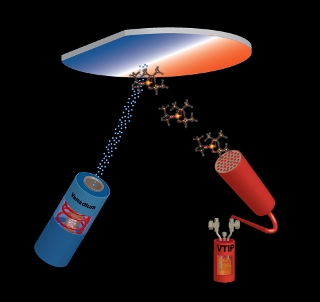Oct 13 2015
The electronics revolution has largely depended upon the tiny transistor, and recently, researchers at the Penn State University (PSU) have formulated a new method to upgrade the transistor by adding vanadium oxide into it.
 Vanadium atoms (blue) and molecules containing vanadium oxide (orange) coat a 3 inch sapphire wafer. Credit: Penn State MRI
Vanadium atoms (blue) and molecules containing vanadium oxide (orange) coat a 3 inch sapphire wafer. Credit: Penn State MRI
"It’s tough to replace the current transistor technology, because semiconductors do such a fantastic job," said Roman Engel-Herbert, assistant professor of materials science and engineering. "But there are some materials, like vanadium oxide, that you can add to existing devices to make them perform even better."
Vanadium oxide is a functional oxide. The team of researchers was aware of vanadium dioxide’s unique property, the so-called metal-to-insulator transition. Basically, electrons travel freely in the metal state, and do not flow freely in the insulator state. Computer logic and memory is based on this on/off transition, which is an intrinsic property of vanadium dioxide.
The PSU team decided that the performance of the transistor could be enhanced by adding vanadium oxide close to the transistor. For instance, incorporating it to the memory cell will enhance the energy efficiency and stability to read, write and maintain the data state.
However, the challenge involved was growing high quality vanadium dioxide as a thin film on an industrial scale (wafer scale), which was never performed before. Vanadium dioxide is quite tough to synthesize despite being a simple element. The vanadium to oxygen ratio has to be accurately controlled in order to achieve better metal-to-insulator transition. Using an appropriate ratio will allow vanadium dioxide to exhibit a resistance change over four order of magnitude for an adequately strong on/off response.
In a paper published in the Nature Communications online journal, the PSU team demonstrated the growth of vanadium dioxide thin films on three-inch sapphire wafers, possessing an ideal vanadium to oxygen ratio of 1:2 spanning the whole wafer. This material can be utilized in the production of hybrid field effect transistors called hyper-FETs. These transistors could pave the way for superior energy efficient transistors.
In an earlier paper published in Nature Communications, another PSU team headed by Prof. Suman Datta illustrated that when vanadium dioxide was added, steep and reversible switching was possible at room temperature, which, in turn, could decrease the impact caused by self-heating, and reduce the transistor’s energy needs.
The benefits do not just stop with that. Current memory technologies, a key area of interest among PSU researchers, can also benefit from the application of vanadium dioxide.
"The metal-to-insulator property of vanadium dioxide can ideally enhance state-of-the-art non-volatile memories by using it as an augmentation device, which, interestingly, can also serve as a selector in some memory architecture," said Sumeet Gupta, Monkowski group leader of the Integrated Circuits and Devices Lab and assistant professor of electrical engineering at Penn State.
When reading or writing data on a memory chip is performed within a single memory cell, a selector insures that this is achieved without spilling into the surrounding cells. The selector performs this by altering the cell’s resistivity, which is made possible by using vanadium dioxide. Altering vanadium oxide’s resistivity leads to amplification of the strength of the read operation to a great extent.
The lead author of the current paper, Hai-Tian Zhang, a PhD student in Engel-Herbert’s group, said, "To determine the right ratio of vanadium to oxygen, we applied an unconventional approach in which we simultaneously deposit vanadium oxide with varying vanadium-to-oxygen ratios across the sapphire wafer. Using this ‘library’ of vanadium-to-oxygen ratios, we can perform flux calculations to determine the optimal combination that would give an ideal 1:2 vanadium/oxygen ratio in the film. This new method will allow a rapid identification of the optimal growth condition for industrial applications, avoiding a long and tedious series of trial-and-error experiments."
Super high frequency switches could be produced using vanadium dioxide thin film material grown with the aid of this innovative technique. This feat was achieved in partnership with the Datta group at Penn State and Notre Dame. These switches are very significant in communications, and can display cut-off frequencies an order of magnitude higher than traditional devices.
In December, this achievement will be demonstrated at the IEEE International Electron Device Meeting, a platform where technological discoveries in the semiconductor and electronic device sector are reported.
"We are starting to realize that the class of materials exhibiting these on/off responses can be beneficial in various ways in information technology, such as increasing the robustness and energy efficiency of read/write and compute operations in memory, logic and communication devices," Engel-Herbert said. "When you can make high quality vanadium dioxide on a wafer scale, people are going to have many excellent ideas on how it can be used."
The current paper is titled "Wafer scale growth of VO2 thin films using a combinatorial approach", and was coauthored by graduate students Hai-Tian Zhang, Lei Zhang, Debangshu Mukherjee, Ryan Haislmaier, and assistant professors Nasim Alem and Roman Engel-Herbert, all in the Department of Materials Science and Engineering and the Materials Research Institute at Penn State, and Yuan-Xia Zheng a graduate student in Penn State’s Department of Physics.
The Penn State Center for Nanoscale Science and the National Science Foundation supported this research. All the analyses and measurements related to this research were conducted in the Penn State Materials Characterization Laboratory, a facility of the Materials Research Institute.